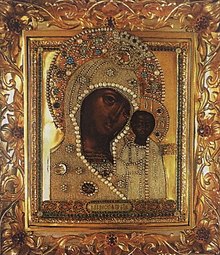
Back Казанская ікона Божай Маці Byelorussian Mare de Déu de Kazan Catalan Делан Ненан Казанан Сурт CE Ikona Naší Paní Kazaňské Czech Турă амăшĕн Хусан турăшĕ CV Gottesmutter von Kasan German Nuestra Señora de Kazán Spanish Kazanin Jumalanäidin ikoni Finnish Notre-Dame de Kazan French Mem Gods fan Kazan Frisian
Our Lady of Kazan | |
|---|---|
 XVII―XVIII century copy (Yelokhovo Cathedral, Moscow) | |
| Venerated in | Eastern Orthodoxy (especially Russian Orthodox Church) Catholicism |
| Major shrine | Kazan Cathedral, Moscow Kazan Monastery of the Theotokos |
| Feast | 21 July 4 November |
Our Lady of Kazan, also called Mother of God of Kazan (Russian: Казанская Богоматерь, romanized: Kazanskaya Bogomater'), is a holy icon of the highest stature within the Russian Orthodox Church, representing the Virgin Mary as the protector and patroness of the city of Kazan, and a palladium of all of Russia and Rus', known as the Holy Protectress of Russia. As is the case for any holy entity under a Patriarchate in communion within the greater Eastern Orthodox Church, it is venerated by all Orthodox faithful.
According to legend, the icon was originally acquired from Constantinople, lost in 1438, and miraculously recovered in pristine state over 140 years later in 1579. Two major cathedrals, the Kazan Cathedral, Moscow, and the Kazan Cathedral, St. Petersburg, are consecrated to Our Lady of Kazan, and they display copies of the icon, as do numerous churches throughout the land. The original icon in Kazan was stolen, and probably destroyed, in 1904.
The "Fátima image" is a 16th-century copy of the icon, or possibly the 16th-century original, stolen from St. Petersburg in 1917 and purchased by F. A. Mitchell-Hedges in 1953. It was housed in Fátima, Portugal from 1970 to 1993, then in the study of Pope John Paul II in the Vatican from 1993 to 2004, when it was returned to Kazan, where it is now kept in the Kazan Monastery of the Theotokos. Copies of the image are also venerated in the Catholic Church.
Feast days of Our Lady of Kazan are 21 July, and 4 November (which is also the Russian Day of National Unity).
© MMXXIII Rich X Search. We shall prevail. All rights reserved. Rich X Search